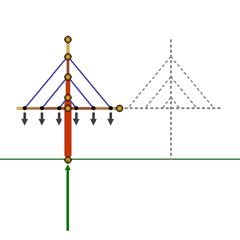
5. Fanlike Structure
 |
5. Fanlike Structure |
| The Screen |
The Form Diagram shows a cable-stayed roof
or bridge with its Force Polygon to the right and numerical
values of member forces below. The left-hand half of the form is provided
with yellow circles to change the loads and configuration. The right-hand
half is automatically mirrored from the left-hand half and cannot be controlled
independently.
The top yellow circle on the tower controls the span and the height of the tower. The circles at the apexes of the cable stays control the locations of the points where the stays join the tower. The Toggle Switches include ones with which you are
now familiar, plus |
||||
|
Keep Deck Horizontal and Keep Tower Vertical,
both of which are self-explanatory.
Harp Configuration: Returns the arrangement of cable stays to a configuration in which the stays are parallel to one another. Fan Configuration: Reconfigures the stays so that they converge at a point where they join the tower.
|
|||||
| Exercise One | Play | ||||
|
Play with the form diagram and toggles, exploring the possibilities and becoming familiar with how the demonstration works. Notice that the loads change in proportion to the span, as they usually do in a real structure.
|
|||||
| Exercise Two | Some Things to Try | ||||
|
A. Toggles on: Keep Tower Vertical and Keep Deck Horizontal |
|||||
| 1. Which stay configuration has lower forces, Harp or Fan?
2. Notice that there are compressive forces in the segments of the deck. Why do these forces occur? Where are these forces largest, and why? 3. Move the points of cable attachment up and down. Observe on the Force Polygon how each change affects the forces in the cables. 4. Move the deck up until it is above the points of attachment of the cables. Move the points of attachment of the cables down to create a form that is the inversion of the original form. What happens to the forces in the cables? Can a structure with this configuration span as far as one with the original configuration? Why or why not? 5. Is there any force between the halves of the structure in the center node above the letter B?
|
|||||
| B. Turn all toggles off. Incline the towers toward
one another and away from one another. |
|||||
| 1. Is there any force between the halves of the structure
in the center node above the letter B? What happens to the reactions at
the bases of the towers?
2. Incline the deck in various directions and explore some of the formal
possibilities for a cable-stayed roof. Do the inclinations of the deck
affect the forces in the various members? |
|||||